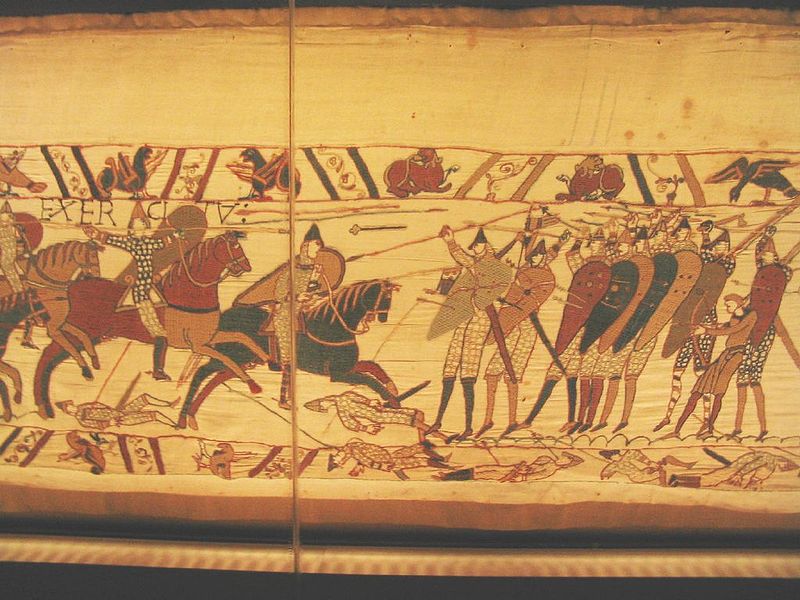“I noticed that seaxes seem to be absent from the Bayeaux tapestry. So far the latest depiction I have found is an illumination from France showing a warrior carrying a seax-shaped knife from ~890 CE. Is there any consensus on when the seax may have been abandoned as a fighting weapon? If there is evidence that seaxes were carried in the 11th c. what form would they be? Are there any examples?”
The demise of the seax as a weapon is an interesting topic and one we have not discussed before. We therefore thought this question warranted a full reply.
 |
| The Bayeux Tapestry: Spears, swords, clubs, maces, bows, but no seaxes!? |
The lack of any representation of larger knives on the Bayeux tapestry may be due to the difficulty of depicting them by embroidery on this scale. However, I note that a number of even smaller items are depicted with good definition. The lack of any depictions of seaxes could be explained as a result of a lack of familiarity, on the part of the designer, with 11th Century English warrior accouterments, but this is difficult to believe if we are to accept the assessment of most scholars that the tapestry was the work of English artisans within a generation of the events depicted. The most reasonable assessment seems to be that the large war knives which feature prominently in the archaeological record from preceding centuries were significantly "out of fashion" at the time of Hastings. There are many reasons why this may have been the case.
It is thought that the large single-edged war-knife became progressively more redundant as swords became lighter and handier to use. As good steel swords became proportionally more affordable and available, there was less need to economize by using a single-edged primary weapon. During the 11th and 12th centuries, warriors seem to have been armed with swords and only carried small utility knives. The ‘dagger’ (in various forms) only re-appears with the advent of plate-armour when knights needed a weapon to finish off opponents which could be slipped between the plates of the harness. During this period we also see the reappearance of what is, to all intents and purposes, a small war-seax in the archer’s and common man’s ðwittle (thwittel). This simple single-edged knife, famously made in Sheffield, is mentioned by Chaucer.
The Middle English name derives from the Old English ðwítel which derives from ðwítan - ‘to cut’.
It is possible that the Hurbuck-style long-seax influenced later English Falchions and that, in Europe, the medieval Lang Messer and Renaissance Große Messer may have evolved from the long tradition of Germanic heavy saxes.
My own opinion is that the heavy whittle-tanged knife is not a continuous tradition but just a good handy design. After all, the classic Sami knives; the small puukko, larger leuko and sax-sized väkipuukko have remained essentially unchanged in design for over 1000 years. The English broken-back seax shape is one which reappears in the 19th century as the Bowie Knife and the later bayonet.
Thus I would suggest that the seax never really became extinct but was constantly evolved to suit changing circumstances.
It is thought that the large single-edged war-knife became progressively more redundant as swords became lighter and handier to use. As good steel swords became proportionally more affordable and available, there was less need to economize by using a single-edged primary weapon. During the 11th and 12th centuries, warriors seem to have been armed with swords and only carried small utility knives. The ‘dagger’ (in various forms) only re-appears with the advent of plate-armour when knights needed a weapon to finish off opponents which could be slipped between the plates of the harness. During this period we also see the reappearance of what is, to all intents and purposes, a small war-seax in the archer’s and common man’s ðwittle (thwittel). This simple single-edged knife, famously made in Sheffield, is mentioned by Chaucer.
“A Shefild thwittle bare he in his hose.”
It is possible that the Hurbuck-style long-seax influenced later English Falchions and that, in Europe, the medieval Lang Messer and Renaissance Große Messer may have evolved from the long tradition of Germanic heavy saxes.
My own opinion is that the heavy whittle-tanged knife is not a continuous tradition but just a good handy design. After all, the classic Sami knives; the small puukko, larger leuko and sax-sized väkipuukko have remained essentially unchanged in design for over 1000 years. The English broken-back seax shape is one which reappears in the 19th century as the Bowie Knife and the later bayonet.
Thus I would suggest that the seax never really became extinct but was constantly evolved to suit changing circumstances.
